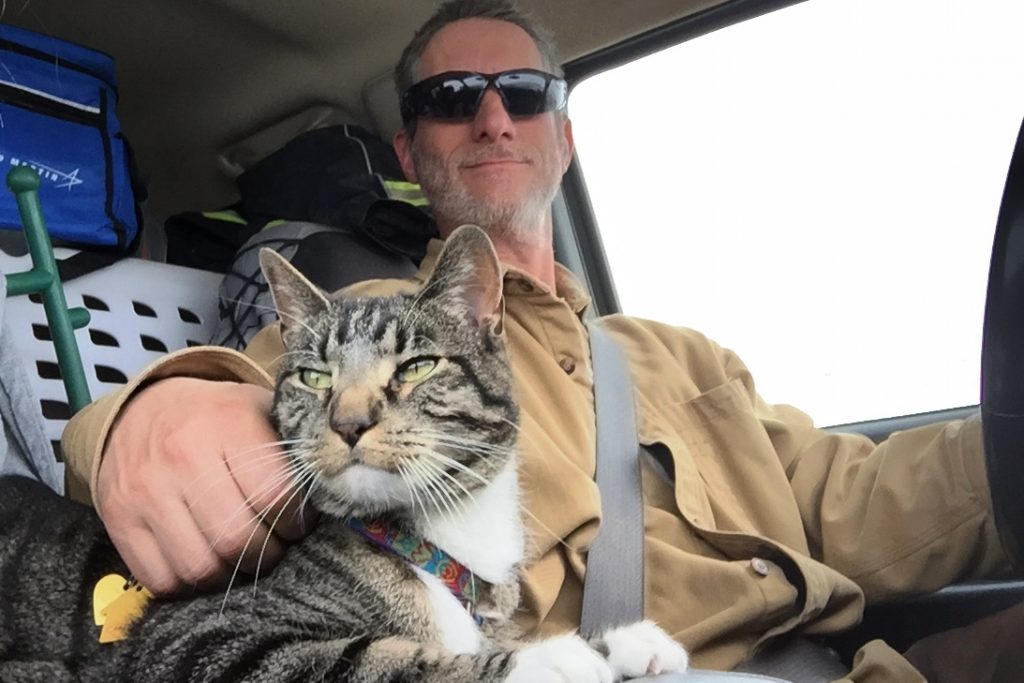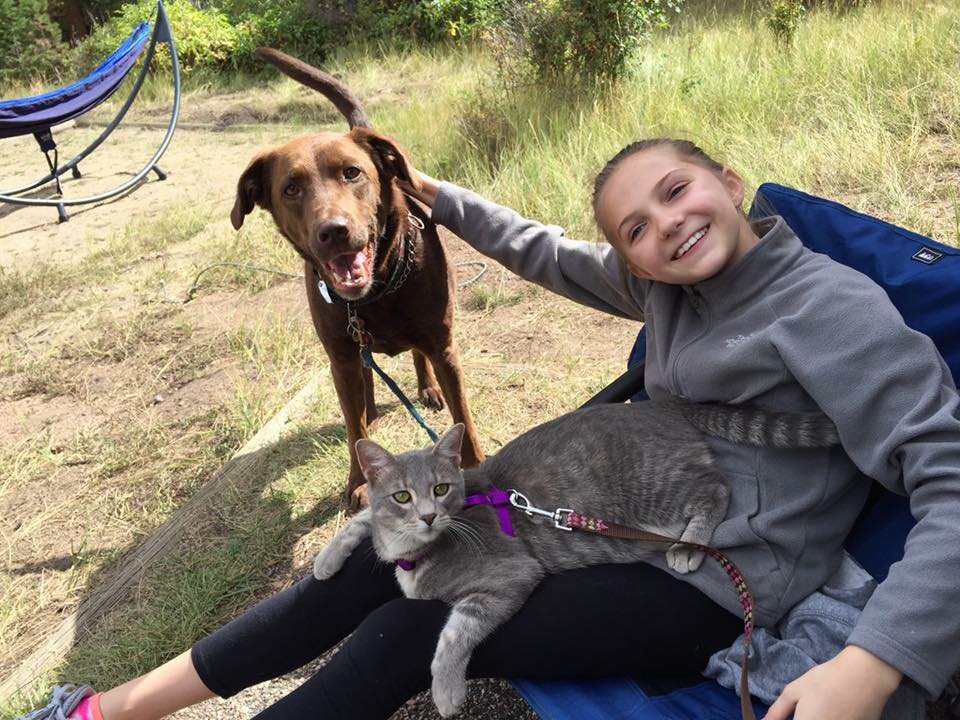Many people take their dogs with them when they hit the road in their RVs. More and more people are traveling with their kitty companions as well. Having your furry buddy with you during your travels gives your trip more of a family feel, reduces stress, and saves money from having to board or find a pet sitter.

My cat is my co-pilot (Photo by TC Wait)
The Hayes family of Castle Rock, Colorado take their family pets (Molly the dog and Nickel the cat) with them on their adventures so that the whole family can enjoy camping together and seeing the sights.
Mom (Roxann) says to be sure to bring a kitty scratcher to keep your upholstered surfaces from being scratched, and a good harness and leash so your kitty can explore its surroundings.
Cats are great escape artists, so a well-fitted harness is better than a collar, and can also prevent neck injuries. Be sure to attach identification tags with microchip information and a good phone number on it just in case!

Get your kitty used to wearing a harness and walking on a leash before you travel with them. (Photo by Roxann Hayes)
The Hayes family starts their kitties getting used to wearing a harness and a leash while they are young around their yard for short excursions, but with patience, adult cats can learn to walk on a leash. Taking short trips with your kitty in the car before your long trip will help your cat become accustomed to road travel.
The family has a truck/trailer set-up, and Roxann recommends that family pets travel in the truck when they are on the road. This helps keep your pets safer and from getting stressed out that their human family isn’t with them while the rig is moving.
Using a travel crate with a soft bed inside will keep your kitty safely secured and out from under the driver’s feet while moving. If you have a healthy adult cat, your kitty shouldn’t need a litter box unless your drive time will be more than about 6 hours. The Hayes family keeps the litter box in the shower to prevent litter from being scattered around the RV and for easier cleanup.
If you have more than one cat, you can use a larger (dog-sized) airline crate and fit a piece of plywood between the two screw-together halves to make an upper loft area and lower area.
You can also use this system for longer trips and include a dishpan or disposable litter box, water dish (hydration is important), and cat bed. Make sure your kitty is familiar with and will use her mobile environment before you travel in order to avoid problems on the road.

The Hayes family camps with Molly the dog and Nickel the cat (Photo by Roxann Hayes)
Once you get to your campsite, let your kitty explore around the RV, but be careful not to let them escape out the door or window!
If you want to allow your kitty to experience the outside, you can use your harness and leash, or a covered portable cattery (be sure to supervise your cat at all times).
Another option is to use an enclosed window perch that can allow your cat to experience the outside environment from a safe enclosure. You may have to make some modifications based on your window design, but a couple of options are the Kitty Peeper from Cats with an Attitude and the Cat Solarium. The Cat Solarium can be customized to fit horizontally or odd shaped windows.
Be sure to consult with your veterinarian before your trip to make sure your feline is up-to-date on shots, microchipped, and healthy for travel. Depending on where you are traveling, your vet may recommend parasite control or other suggestions to keep your kitty healthy and safe.
If you are traveling out of your home state, check with the State Veterinarian’s Office for the state you are traveling to for additional requirements you may need to travel with your cats.
The US Department of Agriculture has a handy website that will direct you to the right place. If you are traveling out of the country, you will need to research requirements for the country you are traveling to.

Just shared this on my dealerships page. Great article!
Very good info, my cat is accustomed to car travel but I wanted to learn more because I’ll be getting a Camper van and I don’t want her to get out. Thank you.
Our cats are indoor cats,so even though we have leashes, and wear their harnesses and tags, they do not go out. Also have a kitty door in the bathroom door, so they can get to litter box as needed. Also have to be diligent about leaving out food and frequent cleaning to deter bugs. Also, it seems feral cats will learn where you are camping and come begging for food. Do not use your own cat dishes to share with other animals!
Our cat (“Squeak”) was already associated with campers when we met her,,, I found her in the suspension of our old op-up, as a very small kitten.
She comes with us on our trips (we now have a TT), and enjoys travel… She’ll either settle on the console between us, or wander about in the back of the Jeep.. One thing we have learned to be wary of.. she does like to “help” with the driving, so she wears a harness and leash in the car too, to keep her out of the driver’s seat or footwell.
At the campground, we have a long line to attach to her harness, so that she can explore with getting into too much trouble. We are careful not to let her get into dense foliage (we live in Florida, home to more stinging and biting things than science has yet counted!) and check for ticks on a regular basis.
IanP
I have a bunkhouse travel trailer that I pull with a Ford full size van. I travel with all my fur babies. I have 13 cats and once in awhile other critters I have rescued. I got the bunkhouse because it gives me plenty of room for litter boxes, feeders, water dishes, beds, lots of toys and scratchers. And I still have some space for my stuff and my boyfriend. Inside the van we build a large cage so the kitties are close to us and they have all the same comforts as inside the RV. I keep spray bottles with water on the inside and outside of the camper door to keep kitties away when we’re using the door. With a little planning you never have to leave the fur babies at home. 😻😻😻😻😻😻😻😻😻😻😻😻😻
We travel with our brat cat in a truck and 5th wheel. She had never gone outside and is not interested in escaping so we don’t bother with leashes or cages (but we always check the door just in case). She does tend to get sick in the first 30 minutes of the first day of travel so we give her a half of a Meclizine pill a while before we leave. They also make her sleepy which helps. While camping she wants a window where she can check out the outside and snooze in the sun so we adjust blinds. Lots of scratching posts and pads help keep her from tearing up the furniture. We keep a litter box in the rear floorboard of the truck.
I wish you would edit the article to read to NEVER travel with your pets in the trailer. First, I think it’s illegal in most, if not all, states. Secondly, good friends were driving on the turnpike, the driver overcorrected after passing and their trailer flipped…within a second it was reduced to a pile of splinters. I saw the accident photos, you never would have known it was a trailer after seeing the wreckage. THANKFULLY the dogs were traveling in the truck, and nobody was hurt. Otherwise and excellent article, thanks!
We have two cats that have traveled with us for over 4 years. They have about 50,000+ miles on them. They know when we are leaving for the road, they set right by the door to be picked up and put in the back seat of our 3500 GMC. When we stop for the night they are put in our 40 ft 5th wheel and they are home until we leave again for the road. They sleep most of time while we are traveling but do get up and look out the side windows and you should see the reaction of people when they look over and see a cat or two looking at them. It is priceless.!!
We travel with our cat in our class C motorhome. He had been to every State west of the Mississippi and 4 Providences. FYI, you need a health certificate from you vet to get your cat back in the US. We have had to get one twice and will get one nect year.
For 10 years we have traveled in our 1994 34′ Class A, no slides RV with two cats: first four years with our older cat. Since then with he and a feral he picked up at home. Our rig comes with a “cat door” in the wheel well of the door. Aside from our first year out a trying to walk the older cat for a few months (he was miserable), and the first year of the feral being kept inside, our two roam free.
Before the negative comments start, yes, we fully understand the danger of wild animals to our cats; we understand that we are breaking the pet rules at the majority of parks.
Honestly, they sleep most of the day. They walk around a few sites near us but stay close to the RV. We walk them every night and they follow along – leashless – like dogs. Unlike dogs they don’t bark incessantly, lunge after other cats, dogs or people, leave poop around for others to step in (they poop 99.9% of the time in their litter box in our shower; we keep an eye on them when outside and pick up the rare territorial poop).
They are chipped, wear ID collars (I keep half a dozen spares) and seen once a year by our Vet. They have probably been in less than a dozen fights with feral cats, have had scratches from the fights get slightly infected and been cured by a Vet maybe once each. Near dusk we shut the cat door for the night.
It’s not for everyone but we have exceptional cats and love travelling with them.
I have been experimenting with ideas to allow my cat(dozer) to travel with me full time. Thru trial and ERROR I found my way to a SM did harness (as the LG cat harness is to tight) . It worked very well on a 25 foot lead. No he’s figured out how to run and shed the attached harness very quickly on the first try. He comes back after dark butt I worry allot about him until then. Looking into tracker but haven’t made choice yet. He’s very smart and it’s imperative that he feels safe and loved while traveling. An unhappy kitty leads to an unhappy trip. Any ideas?